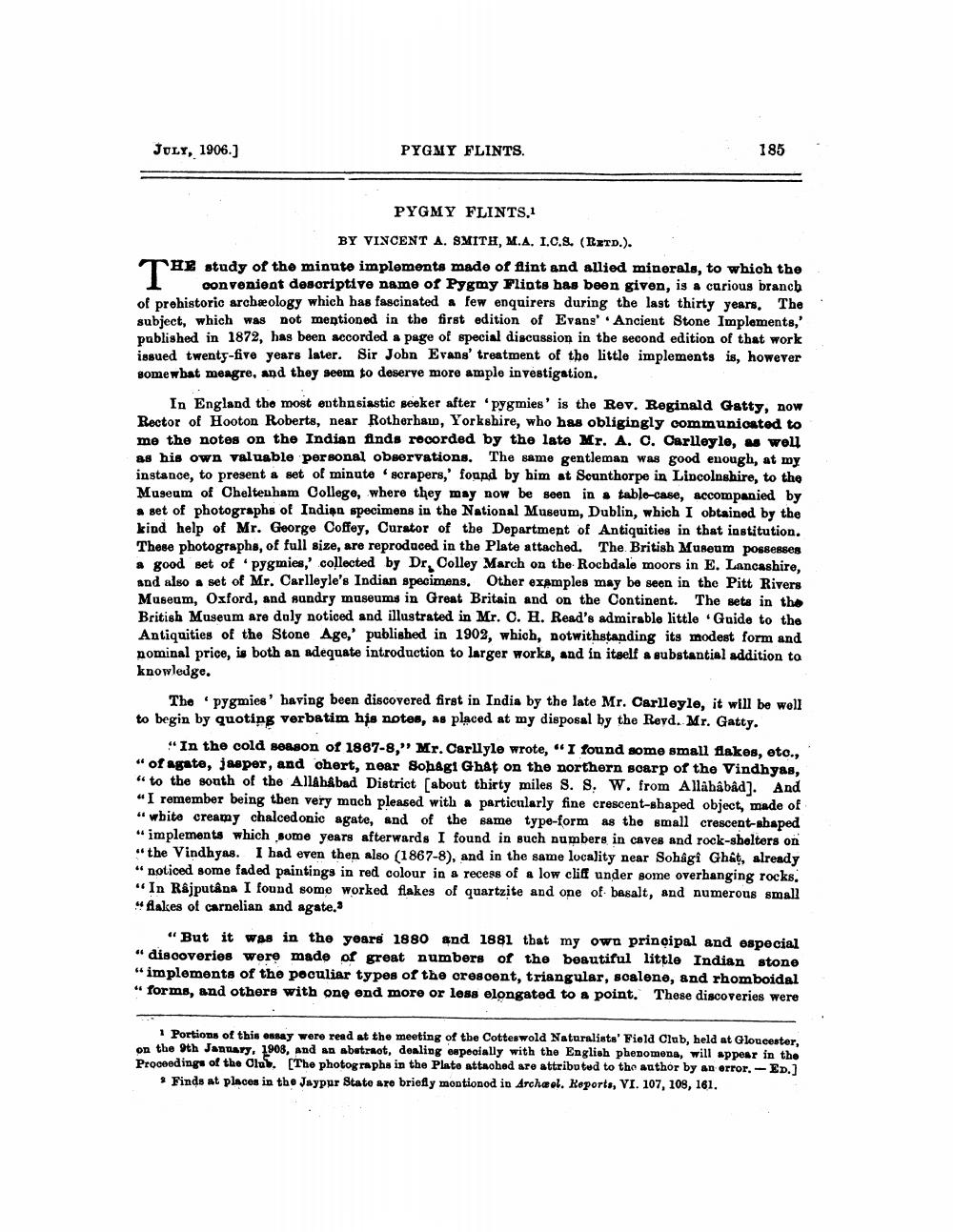________________
JULY, 1906.]
PYGMY FLINTS.
185
PYGMY FLINTS.1
BY VINCENT A. SMITH, M.A. I.C.S. (RETD.).
T
HE study of the minute implements made of flint and allied minerals, to which the convenient descriptive name of Pygmy Flints has been given, is a curious branch of prehistoric archæology which has fascinated a few enquirers during the last thirty years. The subject, which was not mentioned in the first edition of Evans' Ancient Stone Implements,' published in 1872, has been accorded a page of special discussion in the second edition of that work issued twenty-five years later. Sir John Evans' treatment of the little implements is, however somewhat meagre, and they seem to deserve more ample investigation.
In England the most enthusiastic seeker after 'pygmies' is the Rev. Reginald Gatty, now Rector of Hooton Roberts, near Rotherham, Yorkshire, who has obligingly communicated to me the notes on the Indian finds recorded by the late Mr. A. C. Carlleyle, as well as his own valuable personal observations. The same gentleman was good enough, at my instance, to present a set of minute scrapers,' found by him at Scunthorpe in Lincolnshire, to the Museum of Cheltenham College, where they may now be seen in a table-case, accompanied by a set of photographs of Indian specimens in the National Museum, Dublin, which I obtained by the kind help of Mr. George Coffey, Curator of the Department of Antiquities in that institution. These photographs, of full size, are reproduced in the Plate attached. The British Museum possesses a good set of 'pygmies,' collected by Dr, Colley March on the Rochdale moors in E. Lancashire, and also a set of Mr. Carlleyle's Indian specimens. Other examples may be seen in the Pitt Rivers Museum, Oxford, and sundry museums in Great Britain and on the Continent. The sets in the British Museum are duly noticed and illustrated in Mr. C. H. Read's admirable little 'Guide to the Antiquities of the Stone Age,' published in 1902, which, notwithstanding its modest form and nominal price, is both an adequate introduction to larger works, and in itself a substantial addition to knowledge.
The 'pygmies' having been discovered first in India by the late Mr. Carlleyle, it will be well to begin by quoting verbatim his notes, as placed at my disposal by the Revd. Mr. Gatty.
"In the cold season of 1887-8," Mr. Carllyle wrote, "I found some small flakes, etc., "of agate, jasper, and chert, near Sohagi Ghat on the northern scarp of the Vindhyas, "to the south of the Allahabad District [about thirty miles S. S. W. from Allahâbâd]. And "I remember being then very much pleased with a particularly fine crescent-shaped object, made of "white creamy chalcedonic agate, and of the same type-form as the small crescent-shaped "implements which some years afterwards I found in such numbers in caves and rock-shelters on "the Vindhyas. I had even then also (1867-8), and in the same locality near Sohagi Ghat, already "noticed some faded paintings in red colour in a recess of a low cliff under some overhanging rocks. "In Rajputâna I found some worked flakes of quartzite and one of basalt, and numerous small flakes of carnelian and agate.3
"But it was in the years 1880 and 1881 that my own principal and especial "discoveries were made of great numbers of the beautiful little Indian stone "implements of the peculiar types of the crescent, triangular, scalene, and rhomboidal "forms, and others with one end more or less elongated to a point. These discoveries were
1 Portions of this essay were read at the meeting of the Cotteswold Naturalists' Field Club, held at Gloucester, on the 9th January, 1908, and an abstract, dealing especially with the English phenomena, will appear in the Proceedings of the Club. [The photographs in the Plate attached are attributed to the author by an error. - ED.] 2 Finds at places in the Jaypur State are briefly mentioned in Archeol. Reports, VI. 107, 108, 161.




